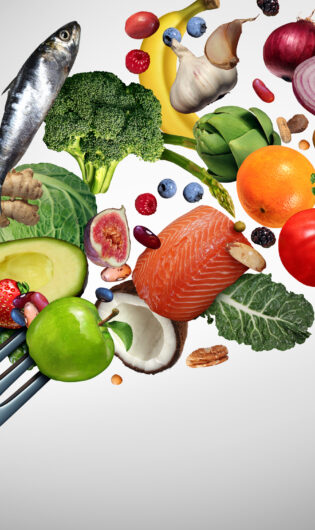Are all ultra-processed foods the same and are they really bad for you?

Freezing a pea, kneading dough, baking a potato. To some extent, these are all forms of modifying our food through cooking, but some processing just can’t be done in the comfort of our own homes. That margarine spread on sliced bread from the supermarket, the pre-prepared vegan ready meal in the freezer, a late night sweet snack: these are all ultra-processed foods, also known as UPFs.
We live in a world where industrial formulations are made from ingredients that can sometimes be tricky to pronounce such as maltodextrin or interesterified oil, using a series of seemingly mysterious processing techniques. It’s impossible to tell from the label whether processes such as hydrolysis, chemical modification, extrusion and moulding have been used to make your food, but does that even matter? Are some foods unhealthy simply because they are ultra-processed?
What are ultra-processed foods (UPFs)?
In 2009, Carlos Monteiro, Professor of Nutrition and Public Health at the University of São Paulo, Brazil, first described the NOVA classification of foods which categorised four types, based on how they had been processed. Unprocessed or minimally processed whole foods include nuts, a steak and a bunch of carrots. Processed culinary ingredients include butter, flour and honey. Processed foods have been salted, fermented, pickled or preserved in some way, for example bacon, smoked salmon, and traditionally-baked sourdough. Then at the far end of the spectrum, ultra-processed foods include ingredients that aren’t normally found in domestic kitchens or restaurants. These industrially-manufactured fizzy drinks, packaged instant soups, margarine, sausage rolls or ready meals often contain additives such as artificial colourings, emulsifiers, preservatives, sweeteners and flavourings.
It’s not always obvious to identify if something has been ultra processed because food manufacturers aren’t obliged to declare to consumers which manufacturing processes they use. Cues lie in the ingredients list – if you spot lots of complex substances that sound like they belong in a lab rather than your own kitchen, the chances are this item has been ultra-processed. But it’s not always that clear cut. Some vegan ready meals, for example, might be classed as UPF yet only contain soy protein, water, salt, and some spices.
Ultra-processed foods are hard to avoid. Global consumption of UPFs is rising and on average, in Britain and the US more than half of the population’s calories comes from UPFs. In the UK, 56% of food intake comes from ultra-processed foods – that’s the highest UPF consumption in Europe and it’s affecting our health and the health of our gut microbiomes, according to some research.
In his new book Ultra-Processed People, doctor and author, Chris van Tulleken states that “UPF is our food culture, the stuff from which we construct our bodies”. And while he emphasises that a lot of UPFs are already considered junk food, he adds that “there’s plenty of organic, free-range, ‘ethical’ UPF too”, saying that indirect processes such as deceptive marketing and secret lobbying are as bad as the food processing itself.
Are all ultra processed foods the same?
Professor Christina Vogel, Deputy Director of the Centre for Food Policy at City, University of London, explains that “all UPFs are damaging to our health when we eat them regularly”. She outlines that scientific evidence suggests that “the high degree of processing, in addition to the poor nutrient profiles of ultra-processed foods, makes this category of food products particularly damaging for people’s health and well-being.” Additionally, she says, many food additives used to manufacture ultra-processed foods, such as flavours, flavour enhancers and colours, are intentionally used to disguise the unpleasant sensory properties created by industrialised food-derived ingredients or processes.
Yet, surely a supermarket-bought plant-based bean burger is healthier than a reconstituted meat sausage roll? Both fall into the UPF category, but in terms of nutritional value, they seem like chalk and cheese. And talking of dairy products, cow’s milk is classed as unprocessed or minimally processed, while plant-based milks are all classed as UPFs yet they vary hugely between types and brands. From soy, almond and coconut, to oat, quinoa and rice, some might be fortified with added vitamins and minerals, while others might contain fewer healthy fats than others.
So many plant-based meat and dairy alternatives are classed as UPFs, but does that make them junk food by definition? They aren’t all unhealthy, as the Soil Association’s Ultra-Processed Planet report highlights: “It is not the case that all plant-based meat and dairy alternatives are intrinsically unhealthy, or less healthy than equivalent meat products, or that all swaps pose a health challenge, and indeed there is evidence that plant-based alternatives can be healthier in some contexts.” But the report warns that when a product is composed of plant protein isolates, industrially manufactured with additives, flavourings, colourings, and binding agents, it’s ‘unlikely’ to offer the same nutritional benefits as the whole plant foods from which it is derived.
Over the past 15 years, the debate about how best to define and interpret UPFs has gained momentum and the more we find out about UPFs, the more the nuances become apparent.
As WWF’s Eating for Net Zero report points out, the link between consumption of UPFs and negative health outcomes, such as increased obesity risk and excess calorie intake, is not yet clear. The study suggests more research is required to investigate whether the sensory properties of the food lead to increased consumption, or the negative health outcomes are due to levels of processing or the average poorer nutritional quality of UPFs.
In a report for the UN’s Food and Agriculture Organization (FAO), Monteiro states that “food processing in itself is not the issue” but warns of the risks associated with UPFs due to the lack of nutritional value.
Some experts describe the NOVA classification of food items as ‘ill-defined’ and concluded in a 2022 paper that “the assertion that ultra-processed foods are intrinsically unhealthful is largely unproven, and needs further examination and elaboration.” More detailed analysis could help counteract any oversimplification by the NOVA classification system.
The truth about nutritional value
When it comes to UPFs, it cannot be assumed that just because a food is plant-based, it’s going to be healthier and low-impact, according to Jennie Macdiarmid, Professor of Sustainable Nutrition and Health at the University of Aberdeen, who describes a ‘halo effect’ around vegan foods that are perceived as healthy regardless of their nutritional profile. As more people switch to flexitarian, vegetarian, and plant-based diets and seek out more meat-free options, they tend to consume more UPFs, according to one French study of more than 21,000 individuals. The researchers concluded that “not all vegetarian diets necessarily have health benefits, because of potential adverse effects of UPFs on nutritional quality and healthiness of diet”. As one 2021 meta-analysis suggests, UPF-rich diets are higher in calories and crucially consist of more sugar, less fibre, and fewer micronutrients. One 2022 report emphasises that “the degree of processing is not necessarily related to food healthiness and naturalness”. So maybe classifying foods solely on manufacturing processes is missing a vital piece of the puzzle.
Spanish plant-based meat alternatives brand Heura has developed a new patent-pending technology called Good Rebel Tech (GRT). Described by Heura as “a relatively quite simple thermomechanical technique”, this involves mixing ingredients with water and applying highly-controlled heating and cooling steps at an industrial scale without the need for additives.
As Isa Fernández Farrés, Science and Technology Director at Heura Foods, explains, this new method enables greater nutritional values to plant protein foods such as ham-style slices and frankfurter sausages made from soy protein and extra virgin olive oil. “We use soy protein because its quality is the highest among all currently available plant protein sources; it comprises all nine essential amino acids (the building blocks of protein) in physiologically optimal proportions. The protein quality also reflects its amino acid bioavailability and digestibility as measured by PDCAAS [protein digestibility-corrected amino acid score],” she explains. Heura’s frankfurters contain just water, soy protein isolate, extra virgin olive, radish, carrot and paprika flavour concentrates, lemon juice from concentrate and vitamin B12. The frankfurters have a protein density of 72% and are much lower in saturated fats and much higher protein in total than pork frankfurters.
The key is to look for high nutritional value – that’s the density (or amount) of nutrients as well as the quality of those nutrients within a product. That’s where the definition of UPF falls down, says Fernández Farrés. “Fundamentally, one of the issues is that the classification [of UPFs] should be based on nutritional value (given by the ingredients), not processing, unless it alters nutrient digestibility in a negative manner. Processing and nutritional value (density and quality) are two independent attributes, and non-mutually exclusive. The UPF category is not only vaguely defined and imprecise, but highly misleading. Existing UPFs classifications are often based on associations from observational studies, not cause-effect evidence in interventional studies e.g. randomised controlled clinical trials. We need an upgraded categorisation which reflects the nutritional values at macro- and micro- levels to accurately define the healthfulness of each food.”
As the British Nutrition Foundation outlines, a loaf of multi-seed wholemeal sliced loaf and a white sliced loaf would both be classified as UPF, but they aren’t the same nutritionally. So just because something has been ultra-processed, doesn’t mean it’s void of all nutritional value. Perhaps, Beyond Burgers and Oumph! Spicy Kebab chunks shouldn’t necessarily sit under the same umbrella as Turkey Twizzlers?
Fernández Farrés explains that it’s important to remember processing is ‘unavoidable’ – most processes are about making food safe. Killing bacteria using heat treatments is beneficial, for example: “But that has nothing to do with nutritional value,” according to the scientist, who explains that some heat treatments might reduce the antioxidant properties of certain heat-sensitive vitamins, while increasing the digestibility of some proteins. “Of course, unhealthy foods have high saturated fats, high starches, high sugar – but this has nothing to do with how something is processed. That’s really misunderstood – these are two separate elements.”
She outlines that it’s easy to assume that products with fewer ingredients on the label are less processed or healthier, but urges shoppers to look at the nutritional values: “You can definitely make a judgement on the health of that product due to nutritional value information but you can’t make a decision about how processed or ultra-processed a food is just from the list of ingredients.”
Food manufacturing is evolving with new tech being designed to ensure that some plant-based UPFs do have a healthier nutritional profile and lower environmental impact.
A team at the Norwegian Institute of Food, Fisheries and Aquaculture Research are investigating the scale-up of six food processing techniques that could help extend shelf-life and reduce food waste. From using high pressure and microwaves to UV light and ultrasound, the team intends to develop an innovative alternative to the energy-intensive autoclave pressure-cooker process that kills off microbes with high heat.
Companies like Heura take pride in starting with quality ingredients such as soy protein and extra virgin olive oil to deliver better nutritional value, and that’s crucial, says Fernández Farrés who wants to see more investment throughout the sector in healthier foodtech solutions. “We have a health crisis at a global level, with so many people being obese and at the same time undernourished from a macro and micro nutrient perspective. That’s a disaster.”
Reformulating ultra processed foods
Dr Kevin D. Hall, a Researcher at the National Institute of Diabetes and Digestive and Kidney Diseases in the US, suggests that while people “with the means and the desire” should be encouraged to replace UPFs with more wholefoods, he describes this category as ‘heterogenous’. So UPFs are not all the same and so the NOVA classification system may be too ‘blunt’ when developing appropriate public health guidelines. “While some UPFs categories (such as sugar-sweetened beverages) should be targeted for reduction, policies targeting elimination of UPFs as a broad category ignore the substantial time, skill, expense, access, and effort required to safely procure enjoyable meals without UPFs—resources that are already in short supply across large swaths of the population.” Hall suggests that reformulation of many common UPFs should be seriously considered, once “more mechanistic UPF research” identifies what makes certain UPFs harmful.
According to Vogel, the NOVA classification system highlights the need for a step-change in how we process and manufacture our food: “It provides evidence and a vision for our food system to produce many more convenient and affordable foods, meals and snacks that are based on wholefoods and move away from foods containing large numbers of food-derived ingredients and additives.”
She says a significant food system shift requires a food and beverage reformulation programme that offers smaller improvements in the nutrient composition of ultra-processed foods. “I believe that the focus for reformulation should be placed on improving the composition of foods traditionally considered to be part of core food groups such as breads, breakfast cereals, yoghurts and meals. This approach would aim to reduce food-derived ingredients and additives that are not found in domestic kitchens and increase the whole-food composition (i.e. wholegrains, whole pieces of vegetables, fruit, pulses etc).”
Many experts, including Vogel, agree that much more research, investigation, and collaboration is required to transform and improve the food system into one that actively supports the health of humans and the planet. She advocates for diets that minimise the intake of UPFs in the interest of both public and planetary health: “We would like to see manufacturers focus on developing convenient, tasty and affordable dishes, meals and snacks that are based on whole and minimally-processed foods. Some products are available, but they are currently priced much higher than the ultra-processed alternatives.” So Vogel would like to see policy changes that reduce the prices of whole foods and increase the price of UPFs in order to improve access to healthier diets for everyone.
As Heura strives to unlock the nutritional value of plant-based foods in ways people couldn’t before, Fernández Farrés concludes that “in order to bust this myth [that all UPFs are unhealthy], you need to have a discussion, with all its nuances and complexities.”








